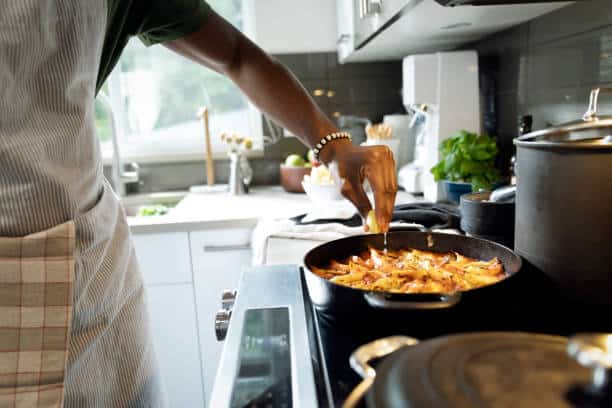Eat Well on Any Budget: 4 Weekly Grocery Plans – BlackDoctor.org


The government, via the USDA, has some thoughts on your budget. Your weekly grocery budget, that is. For a single adult, between the ages of 19 and 50, the USDA estimates that $43 to $80 a week is enough for groceries. Separated by gender and with an age range of 19 to 50, it has cost plans ranging from “thrifty” at $47.90 for males and $41.30 for females, to “low” at $65.70 for males and $57.70 for females, to “moderate” which is $87.60 for males and $73.90 for females, and “liberal” which is $108.90 for males and $95.70 for females.
Do you know where you fall in the age, gender, and grocery cost plan range? And if you do, are you surviving or thriving with enough or pushing your budget to accommodate all the extras with few limits?
If the cost plans break it down and confirm that your weekly grocery purchases are not only budget-friendly but also healthy, then give yourself a gold star. If you thought that cost limits your ability to make healthy food purchases that don’t break the bank, here are some suggestions to eat well on any budget, with a simple sample of what you can eat in a day on the cost plan that suits your budget.
You can maintain a healthy food base and still eat well, regardless of your budget. These creative plans stay within the USDA cost plan range but allow you to add to the most inexpensive meal or subtract from the most expensive cost plan if needed.
By focusing on a diet that emphasizes heavy portions of vegetables, fruits, and beans, and preparing homemade meals with minimal meat, no fried foods, and limited carbohydrates, sweets, fats, and salt, you can maintain a healthy eating plan while also saving money. This approach allows you to have enough budget left over to invest in additional items like herbs, oils, and spices for your pantry, as well as the occasional treat of your choice, provided you have adhered to a healthy foundation and stayed within your budget.
Experiment with Meatless Mondays, Taco Tuesdays, and Fatty Fish Fridays to give some variety to your meals and reach your daily dietary health goals and spending limits. Once you learn how to eat well while sticking to your grocery budget and including healthy ingredients that form a solid foundation, you can enjoy satisfying meals without feeling deprived or worrying about your weekly spending.
Consider the meals featured here as examples rather than limitations. Discover what you enjoy that is healthy, tastes great, and is affordable. Adding more vegetables, fruit, or beans as protein, as done here, you can get good meals that will help fill you up without overspending or adding to your waistline. You might find that you can feel satisfied with less food, and you may even have some leftovers. Just make sure not to spend your entire weekly budget on meals during the first day of the week. Instead, consider eating your leftovers rather than going out to eat.
RELATED: Healthy on a Budget: Grocery Hacks To Try This Weekend

Breakfast
Ahhhhh, breakfast—the most important meal of the day! It’s often the meal you skip in favor of an extra ten minutes of sleep, a refreshing shower, or the challenge of picking an outfit that appears clean, pressed, and as if it took more than five minutes to put together, preferably chosen the night before rather than the morning of. The closest thing you might achieve that breaks your fast in the morning meal time slot is a stale pastry and a dismal cup of gas station lukewarm coffee to drink after you gas up and are on your way to work.
If you stopped snoozing and got up, you could enjoy a hot meal that would keep you satisfied for four to six hours. It checks all the boxes for budget, taste, health, and quick preparation.
Consider oatmeal: it takes just one minute to prepare and four minutes to cook in the microwave. As a budget-friendly staple, a simple bowl of hot oats can be very satisfying. Depending on your food budget, you can choose to add more ingredients to your bowl or keep it basic while still feeling well-fed.
If you have a limited budget for groceries, which we’ll refer to as the “pauper to prince/princess” amount, a bowl of old-fashioned or quick-cooking oats can be a great starting point. Simply add a pinch of salt and prepare it with water or your preferred milk product to make it creamy and delicious. You might have spent like a pauper on the ingredients, but the result would be 100% fit for a prince/ss.
To move into the USDA’s “low” category, you only need to add a few more dollars. Let’s refer to this option as the “cheaper choice.” With the additional funds, you could enhance your breakfast in this category by including a banana, which is both healthy and delicious. The banana adds sweetness with minimal calories. You can slice it in half, mixing one half into your oatmeal while saving the other half for a snack later in the day, if you choose to do so.
The USDA’s “moderate” category provides a larger budget for groceries. Therefore, let’s include some fresh blueberries—frozen blueberries are also an option if fresh ones are out of season. Additionally, you can choose your preferred sweetener, such as brown sugar, turbinado sugar, agave, honey, 100% pure maple syrup, or any of the artificial sweeteners (yellow packet, pink packet, or blue packet). Be careful, however; sweeteners are where things can start to get pricey. The berries add antioxidants and tart flavor, so they’re worth keeping. We’ll call this category “who needs a restaurant?”.
The fourth and final category, the USDA calls “liberal,” and tends to weigh in with a weekly grocery cost plan that is abundantly more than sufficient. If this is you, no judgment. But we’ll call this cost plan “you might be a foodie if…”. You probably spend a good deal of money on food weekly. In this category, you can and do appreciate and indulge in the finer things, so feel free to add chia seeds, ground flax seeds, and/or your favorite nuts or nut butter.
RELATED: 7 Items We Never Buy From The Grocery Store Anymore

Lunch
Whether eating on the go, at your desk, or even in your vehicle, this is not the meal you want to miss…especially if you skipped breakfast. You need nutritious fuel, as you have been operating on empty, to power through the rest of your day.
Let’s begin by making a soup from dry beans in your slow cooker the night before. This “pauper to prince/ss” dish will consist of a simple soup made with beans, sweet onions, garlic, bay leaf, and a touch of salt, once the beans have finished cooking.
To make a “cheaper choice”, add mirepoix, which includes onion, carrots, and celery—some of the most budget-friendly vegetables that also pack a flavorful punch. “Who needs a restaurant? You can easily boost your meal’s nutrients by adding fresh or flash-frozen cut leaf spinach and canned diced tomatoes. These ingredients provide a flavorful punch along with numerous health benefits and essential vitamins. Lastly, consider that “you might be a foodie if…” you made the whole thermos full of soup with a low-sodium chicken stock or broth or vegetable broth and roasted a bulb of garlic to deepen and add to the flavor.

Dinner
The evening meal finds you ready for rest and relaxation at the end of your day if you work the first shift. The “pauper to prince/ss” features a bowl of ramen noodles with green cabbage and kale, without MSG in the high-sodium flavor packet.
The “Cheaper Choice” includes broccoli, green onion, and red bell pepper. The “Who Needs the Restaurant?” option adds shiitake mushrooms and possibly tofu, creating a homemade “monk’s bowl” that tastes even better than the takeout meal from the corner restaurant. And “you might be a foodie if…” you add chicken, shrimp, or miso with no shame, just hunger. Ramen noodles done right, with or without all the add-ins, are a meal to be proud of and can fill you up.

Snacks
The “pauper to prince/ess” enjoys seasonal fruits, while the “cheaper choice” might prefer chips and salsa or an apple. Those who think “Who needs a restaurant?” can snack on cut fresh vegetables and hummus. However, if you consider yourself a foodie, you might indulge in cheese and crackers, possibly paired with an (un?)necessary adult beverage. This makes for the perfect end to an average day that doesn’t require any extraordinary effort—just some planning to ensure you’re well-fed.
These simple, basic, healthy, and delicious meals will test your creativity more than just being a matter of what’s achievable in your budget. You can experiment with getting the maximum from the basic ingredients you can afford. Choose wisely. Dried herbs and spices can bring out the flavor of your food without the health drawbacks of salt, for example. They are a good investment, and you can use them repeatedly for making the same recipe or other simple foods with a similar flavor profile. This enhances the meal and can transform it from “pauper to prince/ss.” It elevates the experience to where “you might be a foodie if…” by adding cinnamon to your morning oats.
You can eat well on any budget by adjusting your expectations away from the overstuffed and overpriced plates of restaurants and fast food meals. Get your taste buds in harmony with good, simple foods that are good for your belly and your budget. Eating according to what’s in season and getting your produce haul from your local farmers’ market will also save you money on your groceries and help you stretch every dollar.
Use your creativity to finish the rest of the days of the week. Continue planning independently and get creative with your budget. Find where you belong and make it work for you if you are spending more or less than you’d like. How much you want to spend is up to you. Either way, you can benefit by eating well if you stay in your current category or change to another cost plan.




